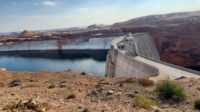The Bureau of Reclamation is taking action intended to prevent the waters of Lake Powell from falling below the level needed to operate the Glen Canyon Dam hydropower plant amid ongoing drought.
Lake Powell’s water elevation was at about 3,522 ft as of May 4. That put the water just 32 ft above the minimum level needed to run the power plant on the Utah-Arizona border, and bureau officials say it’s the lowest the lake’s surface has sat at since it was filled in the 1960s. To protect the reservoir from dropping further, the bureau plans to release an additional 500,000 acre-ft of water from Flaming Gorge Reservoir upstream. Also, the bureau will reduce the amount of water released from the Glen Canyon Dam this year from 7.48 million acre-ft to 7 million acre-ft.
Bureau officials say their plans will help retain nearly 1 million acre-ft of water in Lake Powell through April 2023. The reservoir is the second-largest in the U.S. with a capacity for more than 25 million acre-ft of water, though it is currently holding less than 5.8 million acre-ft. The actions are expected to equate to a 16-ft elevation increase.
This is the first time the bureau has used its authority to change Glen Canyon Dam operations for an entire year. Tanya Trujillo, U.S. Dept. of the Interior assistant secretary for water and science, said in a statement that the decision “reflects the truly unprecedented challenges facing the Colorado River Basin.”
Trujillo said the bureau plans to use Infrastructure Investment and Jobs Act funds to help it address the challenges in maintaining water supply and hydropower. As ENR previously reported, David Palumbo, the bureau’s acting commissioner, told the U.S. House Appropriations Committee on April 27 that the agency is planning multiple courses of action to address Colorado River Basin water issues, including conservation, increased storage, water reuse and desalination.
The Bureau had already released an additional 161,000 acre-ft of water from upstream last year to bolster Lake Powell, and had reduced monthly releases to hold back an additional 350,000 acre-ft during spring 2021.
Record Low Level
Downstream from Lake Powell, Lake Mead has also hit its lowest level since the Hoover Dam was built, according to Trujillo. The water level dropped to expose one of Lake Mead’s intake valves on April 25 for the first time since the lake filled. The low water level even exposed a barrel containing the body of an unidentified person who Las Vegas Metropolitan Police say they believe died of a gunshot wound sometime in the 1970s or early 1980s. In April, Lake Mead’s Low Lake Level Pumping Station, which was completed in 2020, began operating for the first time.
To account for the temporary reduction in releases from Lake Powell, the bureau says it will trigger a new series of releases, though officials didn’t say when those would occur. Water utilities in the lower Colorado River Basin have already instituted water restrictions.
“By working together, water users in Arizona, California and Nevada will continue to make all required shortage reductions and water-savings contributions,” said Jaci Gould, the bureau’s lower Colorado regional director.
The bureau says conservation programs are expected to save 500,000 acre-ft of water in Lake Mead this year and next year.






Post a comment to this article
Report Abusive Comment